|
Batis pririt (Pririt batis)
Priritbosbontrokkie [Afrikaans]; Pririt-vliegenvanger
[Dutch]; Pririt de Vieillot [French]; Priritschnäpper [German]; Batis de pririt
[Portuguese]
Life
> Eukaryotes >
Opisthokonta
> Metazoa (animals) >
Bilateria >
Deuterostomia > Chordata >
Craniata > Vertebrata (vertebrates) > Gnathostomata (jawed
vertebrates) > Teleostomi (teleost fish) > Osteichthyes (bony fish) > Class:
Sarcopterygii (lobe-finned
fish) > Stegocephalia (terrestrial
vertebrates) > Tetrapoda
(four-legged vertebrates) > Reptiliomorpha > Amniota >
Reptilia (reptiles) >
Romeriida > Diapsida > Archosauromorpha > Archosauria >
Dinosauria
(dinosaurs) > Saurischia > Theropoda (bipedal predatory dinosaurs) >
Coelurosauria > Maniraptora > Aves
(birds) >
Order: Passeriformes
> Family: Malaconotidae
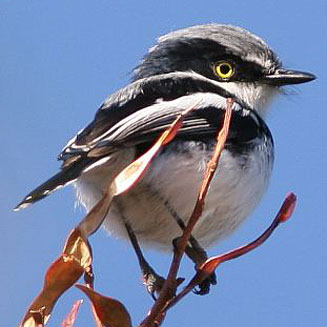 |
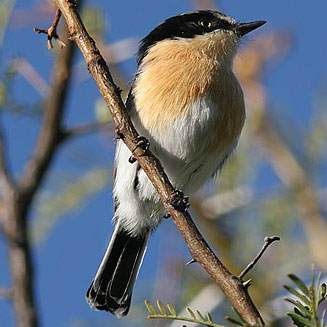 |
| Pririt batis male, Karoo National Park, South
Africa. [photo Trevor Hardaker ©] |
Pririt batis female, Karoo National
Park, South Africa. [photo Trevor Hardaker ©] |
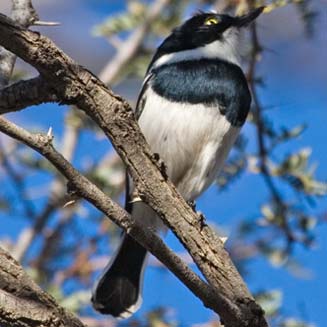 |
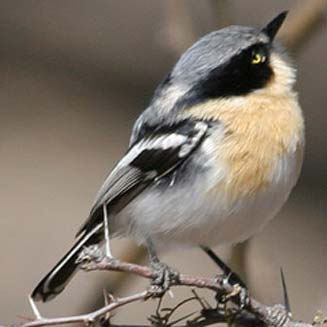 |
| Pririt batis male, Augrabies Falls
National Park, South Africa. [photo
Neil Gray
©] |
Pririt batis female, Augrabies Falls National
Park, South Africa. [photo
Neil Gray
©] |
Distribution and habitat
Near endemic to southern Africa, with the bulk of its
population in arid areas of the Western, Eastern and Northern Capes, Botswana
and Namibia, marginally extending into Angola. It is most common in sem-arid
woodand, especially Acacia thornveld but also jujube (Ziziphus),
raisin (Grewia), shepherds-tree (Boscia) and cluster-leaf
(Terminalia) woodlands. It also occurs along wooded watercourses in deserts
and sem-deserts and also gardens in rural areas of the Karoo.
|
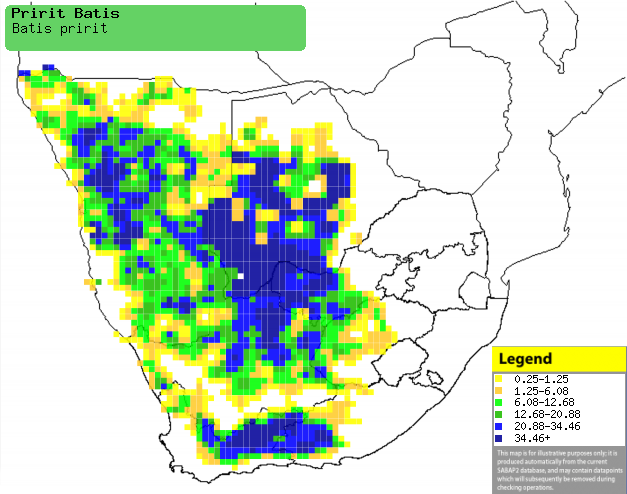 |
|
Distribution of Pririt batis in southern Africa,
based on statistical smoothing of the records from first SA Bird Atlas
Project (©
Animal Demography unit, University of
Cape Town; smoothing by Birgit Erni and Francesca Little). Colours range
from dark blue (most common) through to yellow (least common).
See here for the latest distribution
from the SABAP2. |
Brood parasites
It has been recorded as host of the
Klaas's cuckoo.
Food
It is insectivorous, doing most of its foraging in the
lower canopy of woodlands, gleaning its prey from branches and leaves. It also
joins mixed-species foraging flocks, especially in the cold winter months.
Breeding
- The nest is built mainly by the female, and is a small, compact cup made
of rootlets, grass and plant fibres, bound with strands of spider web. It is
usually placed on a branch of a tree, often resting against a short vertical
twig.
- Egg-laying season is from July-May.
- It lays 1-4 eggs, which are incubated solely by the female for about 17
days, whilst the male provides her with food.
- The chicks are care for by both parents, leaving the nest after about
15-18 days, becoming fully independent up to 6 weeks later.
Threats
Not threatened.
References
-
Hockey PAR, Dean WRJ and Ryan PG 2005. Roberts
- Birds of southern Africa, VIIth ed. The Trustees of the John Voelcker
Bird Book Fund, Cape Town.
|
